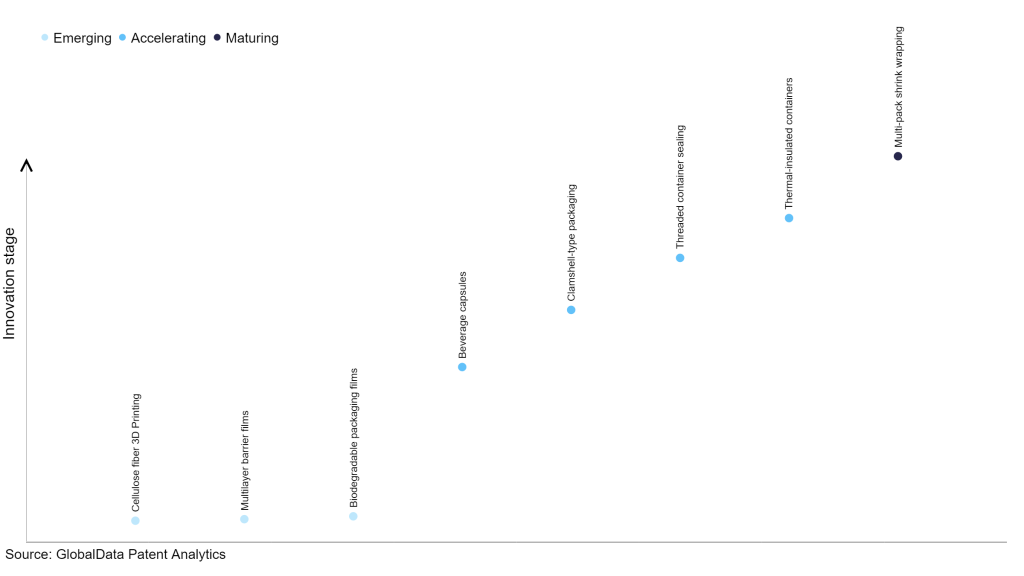The packaging industry continues to be a hotbed of patent innovation. Activity is driven by sustainability, smart packaging, light weight, convenience, and ease of handling and growing importance of technologies such as 3D printing, artificial intelligence, and nano technology. In the last three years alone, there have been over 18,000 patents filed and granted in the packaging industry, according to GlobalData’s report on Innovation in packaging: threaded container sealing. Buy the report here.

Discover B2B Marketing That Performs
Combine business intelligence and editorial excellence to reach engaged professionals across 36 leading media platforms.
However, not all innovations are equal and nor do they follow a constant upward trend. Instead, their evolution takes the form of an S-shaped curve that reflects their typical lifecycle from early emergence to accelerating adoption, before finally stabilizing and reaching maturity.
Identifying where a particular innovation is on this journey, especially those that are in the emerging and accelerating stages, is essential for understanding their current level of adoption and the likely future trajectory and impact they will have.
30+ innovations will shape the packaging industry
According to GlobalData’s Technology Foresights, which plots the S-curve for the packaging industry using innovation intensity models built on over 83,000 patents, there are 30+ innovation areas that will shape the future of the industry.
Within the emerging innovation stage, cellulose fiber 3D Printing, multilayer barrier films, and biodegradable packaging films are disruptive technologies that are in the early stages of application and should be tracked closely. Beverage capsules, clamshell-type packaging, and threaded container sealing are some of the accelerating innovation areas, where adoption has been steadily increasing. Among maturing innovation areas are thermal-insulated containers and multi-pack shrink wrapping, which are now well established in the industry.
Innovation S-curve for the packaging industry

Threaded container sealing is a key innovation area in packaging
Threaded container sealing refers to a method of sealing containers using threaded closures such as screw caps or lids. In this sealing mechanism, the neck of the container (bottle, jar, or other receptacle) typically features threads or grooves, and the closure (screw cap or lid) is designed with corresponding threads. When the closure is twisted onto the container's neck, the threads engage, creating a secure and airtight seal. The seal helps prevent the contents of the container from leaking or spoiling, as well as provides tamper-evident features in many cases.
GlobalData’s analysis also uncovers the companies at the forefront of each innovation area and assesses the potential reach and impact of their patenting activity across different applications and geographies. According to GlobalData, there are 540+ companies, spanning technology vendors, established packaging companies, and up-and-coming start-ups engaged in the development and application of threaded container sealing.
Key players in threaded container sealing – a disruptive innovation in the packaging industry
‘Application diversity’ measures the number of applications identified for each patent. It broadly splits companies into either ‘niche’ or ‘diversified’ innovators.
‘Geographic reach’ refers to the number of countries each patent is registered in. It reflects the breadth of geographic application intended, ranging from ‘global’ to ‘local’.
AptarGroup is one of the leading patent filers in threaded container sealing. Some other key patent filers in the space include Berry Global Group, Danone, and Yeti. In collaboration with Amcor, the European aluminum supplier Aludium created an environmentally-friendly aluminum product suitable for screw caps. The innovation aims to reduce carbon emissions in the production of screw cap closures.
In terms of application diversity, AptarGroup leads the pack, while Berry Global Group and Yeti stood in the second and third positions, respectively. By means of geographic reach, Kimberly-Clark held the top position, followed by Stanpac and Seda.
Threaded container sealing will be adopted by a greater number of companies especially in sectors including food and beverage, pharmaceuticals, and cosmetics in the coming years. Threaded closures provide a secure and airtight seal, which helps preserve the freshness and quality of the contents. This is especially important for perishable goods such as food and beverages. Furthermore, many threaded closures come with tamper-evident features, such as a breakable seal or a visible thread, which provide consumers with confidence that the product hasn't been tampered with before purchase. To further understand the key themes and technologies disrupting the packaging industry, access GlobalData’s latest thematic research report on Packaging.
Data Insights
From

The gold standard of business intelligence.
Blending expert knowledge with cutting-edge technology, GlobalData’s unrivalled proprietary data will enable you to decode what’s happening in your market. You can make better informed decisions and gain a future-proof advantage over your competitors.




